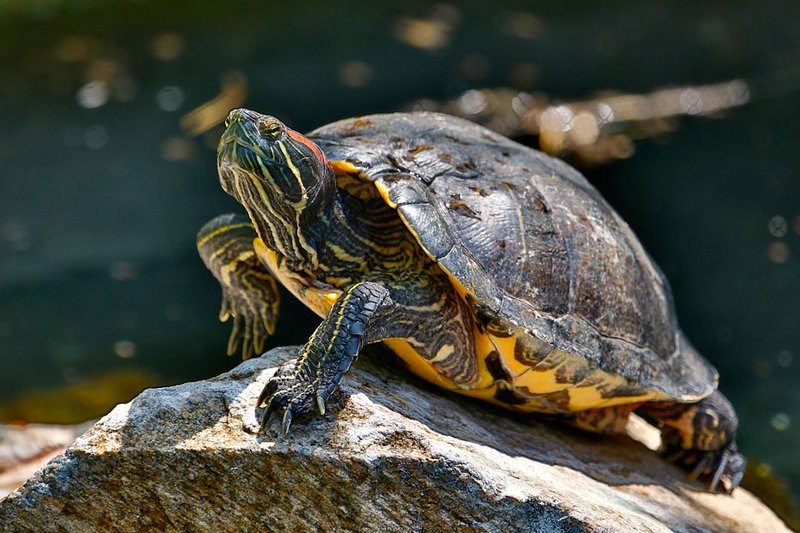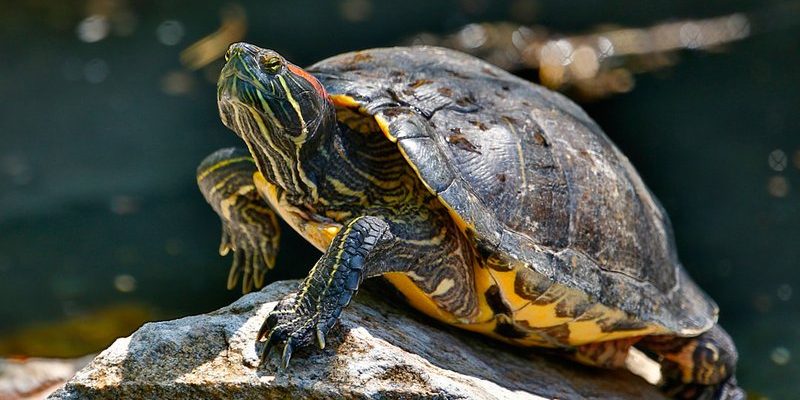
The Red-Eared Slider is one of the most popular pet turtles in the world, and for good reason! With their vibrant, striking colors and personable nature, these little guys have captured the hearts of many. It’s like having a tiny swimming companion right in your living room! But what makes them so appealing? And what should you know before bringing one into your life? Let’s dive into the fascinating world of the Red-Eared Slider.
Native to North America, these turtles are easily recognized by the distinctive red stripes behind their eyes. They are not just eye-catching; they also have some interesting habits and characteristics that set them apart from other turtle species. Picture them basking under a warm light, stretching their legs in a sunny spot, or munching on tasty greens. They have a unique charm that makes them both entertaining and easy to care for—if you know what you’re doing!
Physical Characteristics
The Red-Eared Slider is a medium-sized turtle, typically measuring about 5 to 10 inches in shell length, though some can grow larger. Their shells are mostly green with a pattern of darker lines and a characteristic red stripe on either side of their heads. This striking feature is what gives them their name and makes them easily identifiable. The shell is not just for looks; it serves as a natural armor, providing protection from predators.
As they grow, their carapace—what we commonly think of as their shell—can change color and texture. Younger sliders have smoother shells, while adults tend to show more texture and may even fade a bit in color. These turtles also have webbed feet, perfect for their aquatic lifestyle. When they swim, they glide gracefully, making it look like they’re flying underwater!
Habitat and Distribution
Red-Eared Sliders originate from the southeastern United States and can often be found in ponds, lakes, and slow-moving rivers. They thrive in freshwater habitats where they can bask in the sun and dive into the water for safety. When it comes to choosing a home, they prefer areas with plenty of warm sunlight—after all, basking is a big part of their daily routine!
Over the years, these turtles have been introduced to many other regions, including Europe and Asia. Unfortunately, this has led to them becoming an invasive species in some areas. They outcompete local turtle populations for resources, which can disrupt local ecosystems. If you’re thinking of taking care of a Red-Eared Slider, be sure to consider local wildlife regulations to ensure you’re complying with them.
Diet and Feeding
In the wild, Red-Eared Sliders are omnivores, which means they enjoy a varied diet consisting of both plants and animals. They typically eat aquatic vegetation, insects, and small fish. You might find them munching on water lettuce or snapping up a juicy worm. This diverse diet is crucial for their health and growth. You should aim to replicate this diversity in captivity.
When feeding your Red-Eared Slider, consider offering a combination of commercial turtle pellets, fresh vegetables like collard greens, and occasional protein sources like cooked shrimp or small fish. It’s vital to keep an eye on how much they eat—overfeeding can lead to health issues. Providing a balanced diet is key to keeping your turtle vibrant and active.
Behavior and Socialization
Red-Eared Sliders are generally social creatures. In their natural habitats, you’ll often see them basking together, which fosters a sense of community among them. As pets, they can exhibit a range of behaviors from curiosity to shyness. They might become familiar with their owners over time, recognizing when it’s feeding time or when you’re there to offer a little attention.
However, while they can be sociable, it’s essential to provide a proper environment for your slider. This includes a warm basking area and plenty of water to swim around. If they feel stressed or cramped, they may retreat into their shells or hide. By giving them enough space and the right conditions, you’ll help them thrive and build a bond with you.
Breeding and Life Cycle
Breeding Red-Eared Sliders can be an exciting but challenging endeavor. Typically, they reach sexual maturity between 3 to 5 years of age. Female sliders will lay eggs in sandy or soft soil, usually in the spring or summer. It’s fascinating to see the process unfold as they create nests and lay anywhere from 2 to 30 eggs at a time.
Once the eggs are laid, they incubate for about 60 to 90 days before hatching. The hatchlings are incredibly vulnerable, so they don’t stay in the nest for long. Instead, they scurry towards the water, where they’ll begin their lives. If you ever observe hatchlings, it’s a heartwarming sight to see them take their first plunge into their aquatic world!
Housing and Care
Creating the right environment for your Red-Eared Slider is crucial for its health and happiness. A large aquarium or a pond is ideal, as these turtles need ample space to swim and bask. The water should be kept clean and warm, ideally between 75°F and 80°F, with a basking area that reaches around 85°F to 90°F.
Make sure to include a water filter to help maintain clean water. Regular cleaning is essential, as sliders can be quite messy! Adding some rocks and driftwood can provide them with hiding spots and climbing areas, mimicking their natural habitat. Remember, the more enriched their environment, the happier and healthier they will be.
Health Considerations
Like any pet, keeping your Red-Eared Slider healthy is a priority. Regular check-ups with a vet who specializes in reptiles can help catch any potential health issues early on. A common problem in captive sliders is shell rot, often caused by poor water quality or lack of proper diet. Make sure to observe your turtle’s behavior and look for any signs of illness, like lethargy or loss of appetite.
Feeding them the right diet and ensuring they have enough UVB light for proper shell growth are vital. Turtles rely on ultraviolet light for their health, much like we need sunlight for vitamin D. Without it, they can develop metabolic bone disease, which is dangerous and can be difficult to treat.
Conservation Status
While Red-Eared Sliders are common pets, in their natural habitats, they face challenges from habitat loss and invasive species. Current conservation efforts focus on educating the public about responsible pet ownership to help prevent these turtles from being released into the wild. It’s vital for every pet owner to understand the impact their pet can have on local ecosystems.
By keeping turtles like the Red-Eared Slider as pets responsibly, we can help protect them and their habitats. Supporting local conservation initiatives and respecting wildlife regulations is key to ensuring these wonderful creatures continue to thrive in the wild for generations to come.
| Fact | Description |
|---|---|
| Scientific Name | Trachemys scripta elegans |
| Size | 5 to 10 inches (13 to 25 cm) |
| Diet | Omnivorous (plants, insects, small fish) |
| Lifespan | Up to 30 years in captivity |
| Habitat | Ponds, lakes, rivers |
| Behavior | Social and curious |
FAQ
Can Red-Eared Sliders live together in the same tank?
Yes, Red-Eared Sliders can sometimes live together, but it’s essential to monitor their behavior. Like people, turtles have different personalities; some may be more territorial than others. Ensure there’s enough space and hiding spots in the tank to reduce potential conflicts. If you notice any aggressive behavior, it’s best to separate them.
What do I feed my Red-Eared Slider? Can they eat fruit?
Red-Eared Sliders need a balanced diet that includes commercial turtle pellets, fresh greens, and occasional protein like insects or shrimp. While they can eat some fruits in small amounts, it’s important not to overdo it, as too much sugar can lead to health issues. Think of fruit as a special treat rather than a regular meal!
How do I tell if my turtle is male or female?
Distinguishing between male and female Red-Eared Sliders can be tricky, especially when they’re young. Generally, adult females are larger than males and have a flatter shell. Males often have longer nails and a more vibrant coloration. If you’re unsure, a vet or a knowledgeable pet store employee can help you determine the sex.
How often should I clean my turtle’s tank?
Cleaning your turtle’s tank is crucial for their health. You should perform partial water changes weekly, replacing about 25-50% of the water. A thorough tank cleaning every month or so is also recommended to prevent buildup of waste and algae. Regular maintenance will keep the environment healthy and safe for your turtle.
Do Red-Eared Sliders hibernate?
In the wild, Red-Eared Sliders can enter a state of dormancy during cold months, but in captivity, they typically don’t hibernate if kept in warm conditions. However, if temperatures drop significantly, they may slow down and become less active. It’s essential to provide a stable, warm environment year-round to keep your sliders healthy and active.
Can they live in saltwater?
No, Red-Eared Sliders are freshwater turtles and are not equipped to live in saltwater. Saltwater can be harmful to them and lead to health issues. Always ensure your slider has access to clean, freshwater for the best quality of life.
What should I do if my turtle is not eating?
If your Red-Eared Slider stops eating, it can be concerning. First, check the water temperature and quality, as poor conditions can cause stress. Try offering a variety of foods to entice them. If they continue to refuse food for more than a few days, consult with a vet to rule out any underlying health issues.
How long can Red-Eared Sliders stay out of the water?
Red-Eared Sliders can stay out of water for several hours if they’re basking comfortably, but it’s important they have access to water to rehydrate. In captivity, ensure they have a proper basking spot and a clean swimming area available at all times. Staying hydrated is essential for their overall health.
Are Red-Eared Sliders good pets for beginners?
Yes, Red-Eared Sliders can be great pets for beginners! They are generally low-maintenance once their habitat is set up correctly. However, it’s important to do your research and understand their needs, such as diet and habitat requirements. Understanding what it takes to care for one can lead to a rewarding experience.
Can I take my turtle outside for exercise?
Taking your Red-Eared Slider outside can be a great way for them to enjoy some natural sunlight, but it should be done carefully. Make sure the area is safe, secure, and free from potential predators. Supervise them closely to prevent escape or injury. A sunny spot for short periods can be beneficial, but always keep their needs in mind!

